Thank you Veterans for serving our country and protecting our freedoms.
— The staff at TBR News Media
— The staff at TBR News Media
By Tara Mae
Seasons greetings from St. George Living History Productions in conjunction with the Leo P. Ostebo Kings Park Heritage Museum! On Saturday, Nov. 19, at 11 a.m., St. George Living History Productions will present the Holly Jolly Holiday Party, at RJO Intermediate School, 99 Old Dock Road Kings Park which houses the museum.
The two hour extravaganza, featuring a lecture, Q&A session, and luncheon, is St. George Living History Productions’ first in-person event in more than two years. It is a multifaceted celebration of holiday television specials of the past and the festive spirit of the present.
“This is not just a lecture, it is a holiday party. There will be some games, dancing, and fun. The playlist will consist of classic holiday favorites,” said Sal St. George, co-founder of St. George Living History Productions. “People are going to have a wonderful time and it will bring back so many nostalgic memories.”
Unforgettable musical interludes include clips featuring timeless stars such as Julie Andrews, Lucille Ball, Ella Fitzgerald, Danny Kaye, Nat King Cole, Johnny Mathis, Bing Crosby, and David Bowie. Classic holiday films will also be represented with scenes from “It’s a Wonderful Life” and “White Christmas.”
Even the lunch menu embraces the theme of holiday nostalgia, featuring recipes from The Frank Sinatra Celebrity Cookbook. “All of the food we serve are celebrities’ favorites,” said Darren St. George, creative director of St. George Living History Productions.
Bringing history to life and honoring the past as it informs the present and inspires the future are tenets of Sal and Darren personally and St. George Productions professionally.
The production company is a family affair. Founded over 30 years ago by Sal and his wife Mary, Darren joined his parents in the business at a young age. Now Darren’s wife Cassandra also works for the company. This mini-community formed from strong interpersonal connections is a key force behind-the-scenes, and Sal wants others to be able to create such bonds through the links of shared interests and communal warmth.
During the start of COVID lockdown, Darren developed a plan to offer Sal’s entertainment lectures via Zoom. This then expanded into virtually touring celebrity and cinema history museums, with proceeds going to benefit those organizations. Sal still does a weekly Zoom lecture on Mondays.
Envisioned by Sal years ago as a community building event that celebrated the merriment of televised holiday concerts and variety shows, the Holly Jolly Holiday Party strives to invoke the comfort of these viewing experiences while encouraging attendees to celebrate the company of each other. And, as with any St. George production, the underlying theme is entertainment that is both educational and ebullient.
“This is something I have wanted to do for a long time,” Sal said. “People are going to have a wonderful time and it will bring back so many nostalgic memories. We want people to walk out of there with smiles on their faces.”
That goal is shared by Dr. Timothy Egan, superintendent of the Kings Park School District, which includes RJO Intermediate School. Sal and his wife Mary, the other co-founder of St. George Productions, originally reached out to him about a potential collaboration prior the pandemic.
“I am looking forward to history being brought to life. I am also looking forward to hosting history-related events at RJO Intermediate School once again. The building (1928) was the original K-12 site of the Kings Park Central School District,” Egan said.
“There are quite a few people that are by themselves and we welcome them to come and be party of the family — they should not feel funny coming by themselves…People have had such a hard time the past few years, and we want to help them put that behind them,” Sal said.
$1 of each ticket sale goes directly to the Leo P. Ostebo Kings Park Heritage Museum, which was created in 1994 and officially established by the Kings Park Central School District’s Board of Education to preserve the history of the hamlet of Kings Park.
For individuals who prefer to virtually attend the party, it will be broadcast via Zoom. Tickets may be purchased online at www.stgeorgelivinghistory.com.
On Tuesday, Nov. 8, the Commack School District experienced a network outage, according to a press release from the district.
It was determined by the district’s network engineers that this service disruption is a result of a ransomware virus.
“At this time, we have contacted federal, state and local authorities, including Homeland Security, and we are working closely with our cyber Insurance carrier.,” the statement read. “Ransomware such as this is a criminal act, and an investigation is currently underway. There is no evidence at this time that any student or staff information has been accessed.”
The district will continue to work with law enforcement agencies and its team to resolve the issue.
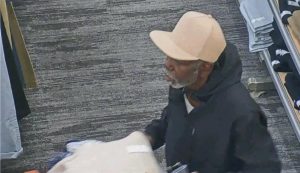
Suffolk County Crime Stoppers and Suffolk County Police Fourth Precinct Crime Section officers are seeking to identify and locate a man who allegedly stole from a Commack store in October.
A man allegedly stole $680 worth of clothing from Target, located at 98 Veterans Memorial Highway, at 11:45 a.m. on October 30. He left the scene in a blue Toyota Camry.
Suffolk County Crime Stoppers offers a cash reward for information that leads to an arrest. Anyone with information about these incidents can contact Suffolk County Crime Stoppers to submit an anonymous tip by calling 1-800-220-TIPS, utilizing a mobile app which can be downloaded through the App Store or Google Play by searching P3 Tips, or online at www.P3Tips.com. All calls, text messages and emails will be kept confidential.
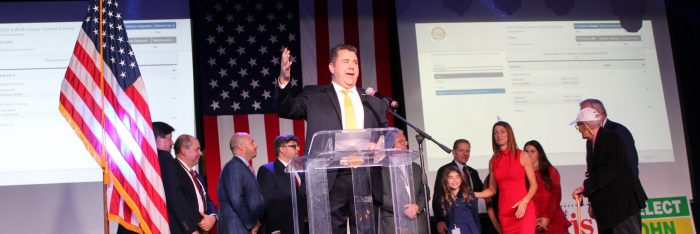
While New Yorkers voted Democrat Kathy Hochul as the first woman elected governor, Republicans scored big in races throughout Suffolk County.
Due to September’s cyberattack, results for local races were delayed on Tuesday night as Suffolk County election workers struggled to upload votes.
After technical problems, election workers delivered voting booth memory cards to Yaphank headquarters for votes to be counted. The first voting results started trickling in by the early morning hours of Nov. 9.
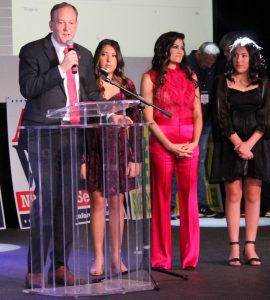
New York State governor
Congressman Lee Zeldin (R-NY1), the Republican Party’s gubernatorial candidate, made a surprise appearance en route to his official viewing party in Manhattan. At the Stereo Garden in Patchogue, Zeldin expressed gratitude for the people of Suffolk County, saying his night would not be complete without first dropping in.
Slowly, the returns began to come in, and the room took on a different tone and tenor as the gubernatorial contest was called for incumbent Hochul.
With 94% reporting as of press time, Hochul carried the state by a 53-47% margin — unusually tight for a state that Democrats generally take handily.
“Tonight, you made your voices heard loud and clear, and you made me the first woman ever to be elected to be the governor of the State of New York,” Hochul said in her victory speech. “But I’m not here to make history. I’m here to make a difference.”
Zeldin conceded the afternoon of Nov. 9 in a statement.
“This race was a once-in-a-generation campaign, with a very close margin in the bluest of blue states,” Zeldin said. “The unrelenting passion and hard work of our grassroots volunteers and supporters made this incredibly close race possible and helped us win at least 49 of New York’s 62 counties.” He added, “Republicans, Democrats and Independents united as New Yorkers, pouring their heart and soul into this campaign.”
Congress
U.S. Sen. Chuck Schumer (D-NY) was declared the victor early on Nov. 8, receiving 56% of the votes as of press time.
Despite this and a lackluster Republican performance nationwide, some at Stereo Garden did have cause to celebrate. In the race to fill Zeldin’s congressional seat, Nick LaLota defeated Suffolk County Legislator Bridget Fleming (D-Noyac) by a 56-44% margin with 94% reporting.
“Thank you to the voters of Suffolk County for placing your trust in me,” LaLota said in a statement. “I am extremely thankful for the trust and confidence you have placed in me, and I won’t let you down.”
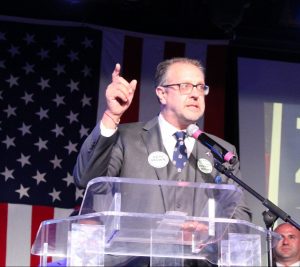
State Legislature
At the state level, incumbent state Sen. Anthony Palumbo (R-New Suffolk) defeated Democratic Party challenger Skyler Johnson by 12 points. “This is a team effort, as you all know, and we don’t get here without the hard work of all of our volunteers,” Palumbo said in a speech.
Johnson said he wouldn’t make any promises about whether to run for another office. However, he hasn’t ruled it out, either.
“If I think that we have a viable path, and I think that what I can offer is what the constituents need, then ‘yes,’” he said.
State Sen. Mario Mattera (R-St. James) faced Democrat Susan Berland, formerly Suffolk County legislator in the 16th District and Town of Huntington councilwoman, for the seat in the 2nd District.
The incumbent retained his seat with more than 58% of the votes. Mattera said it felt great to hear the results of his race the morning of Nov. 9, even though he was disappointed that Zeldin lost the gubernatorial race.
“One party rule is upsetting to me because it’s like a business having a monopoly,” Mattera said.
The state senator said he is looking forward to returning to Albany to continue working toward bringing funds back to the area to help with infrastructure and local businesses. He added he was appreciative of the overwhelming support from his family, friends, law enforcement and trade unions, and the confidence they all have had in him.
In the state Assembly, incumbent Assemblywoman Jodi Giglio (R-Riverhead), who represents the 2nd District, easily won her race by a 32% margin over Democratic challenger Wendy Hamberger.
As of early afternoon Nov. 9, the race for Assembly District 4 was tight, with a mere 973 votes dividing the candidates. Incumbent state Assemblyman Steve Englebright (D-Setauket) is in a competitive bout with Republican challenger Edward Flood. Flood maintains a 2-point lead with 96% of the precincts reporting as of press time, though that race has not been called.
Englebright said his last race in 2020 was a close one, too, and he was not ready to make an official statement as of press time.
In the state Assembly District 8 race, incumbent Michael Fitzpatrick received more than 68% of the votes. His opponent, Democrat Jeanine Aponte, did not run an active campaign.
In addition to parts of Suffolk County, state Assembly District 10 also takes in parts of Nassau County. Incumbent Steve Stern (D-Dix Hills) was the winner with 54% of the votes (25,879), while IT professional Aamir Sultan (R) received 46% (21,843).
In the state Assembly race in the 12th District, incumbent Keith Brown (R-Northport), faced Democrat Cooper Macco.
Brown retained his seat with 58% of the votes. Macco said he would consider running for office in the future.
“It was a learning experience,” he said. “I think that in the future, hopefully, I can take what I’ve learned” and apply it to a campaign.
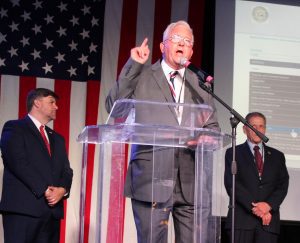
Suffolk County
After losing a June primary, current Suffolk County Clerk Judith Pascale (R) did not run for the position.
Republican Vincent Puleo, the town clerk of Smithtown, faced Democrat Lisa Jimenez, a newcomer running for political office. Puleo won the race with 59% of the votes.
Incumbent county Comptroller John M. Kennedy Jr. (R) won reelection with ease at 60% over his inactive Democratic Party challenger, Thomas Dolan. During a speech at Stereo Garden, he thanked those who helped him secure victory and expressed his vision for the future.
“We left nothing untouched, ladies and gentlemen,” the comptroller said. “We will have change in Suffolk County, and we will restore Republican values, I’m confident.”
Propositions
The $4.2 billion state Clean Water, Clean Air and Green Jobs Environmental Bond Act of 2022 was approved by about 59% of voters (93.64% precincts reporting).
The Suffolk County term limits proposition, to 12 years total, passed with a massive 86% approval.
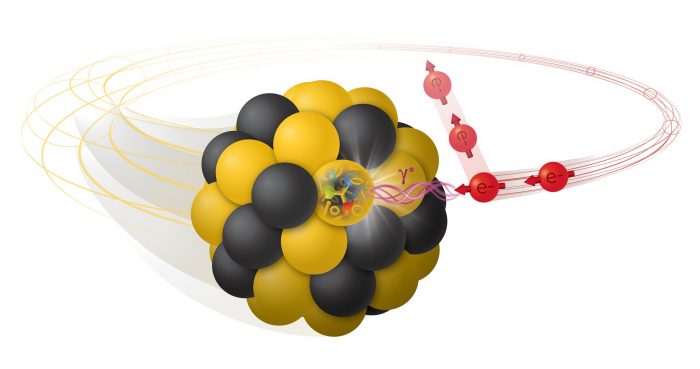
National labs, including Brookhaven National Laboratory, received considerable additional funds as a part of the federal Inflation Reduction Act.
BNL, which will get an additional $224 million over a five-year period, will collect the additional funding from the Department of Energy’s Office of Science to support several projects designed
In a statement, Secretary of Energy Jennifer Granholm called the additional funds for energy-related research and support, which total $1.5 billion, “one of the largest ever investments in national laboratory infrastructure” and suggested that the effort would “develop advanced energy and manufacturing technologies we need to advance the frontiers of science and tackle tomorrow’s challenges.”
At BNL, the Electron-Ion Collider, an enormous project that will start construction in 2024 and should start running experiments in the early part of the next decade, will receive $105 million.
BNL is building the EIC in partnership with the Thomas Jefferson National Accelerator Facility in Virginia, which will also receive $33 million for work towards the new facility.
As its name suggests, the EIC will collide electrons and protons or heavier atomic nuclei and hopes to make numerous discoveries, including providing an understanding of how the energy from quarks and gluons provides the mass of a proton.
Additionally, the EIC will provide advances in health and medicine, national security, nuclear energy, radioisotope production and industrial uses in particle beams. Research on the technologies that will become a part of the EIC will advance the development of magnets and other particle accelerator parts. These advances could lead to energy efficient accelerators, shrinking the size and costs of future accelerators, which could attack cancer cells, design solar cells and batteries and develop drugs and medical treatments.
While the additional funds will help advance the development of the EIC, the total cost is considerably higher, at an estimated $1.7 billion to $2.8 billion.
Beamlines
Additionally, the Office of Science will provide $18.5 million to speed the creation of three new beamlines at the National Synchrotron Light Source II.
The NSLS II already has a host of beamlines that enable researchers from around the world to study the structure of batteries as they are operating, catalysts that help tap into energy sources, and biologically active molecules that could play a role in understanding basic biochemistry or that could lead to the development of drugs.
The new beamlines, which, like others at the NSLS II, have three-letter abbreviations. The ARI will provide a complete picture of the electronic structure of a sample, particularly in connection with temperature, chemical, structural and atomic variation.
ARI will help understand and control the electronic structure of next generation quantum materials.
CDI, meanwhile, will explore the condensed matter macroscopic and microscopic physical properties of matter, including the solid and liquid phases that arise from electromagnetic forces between atoms. CDI is in its final stages of its design.
The SXN will provide element access from carbon to sulfur. The beamline will offer measurements of different signals, such as X-ray fluorescence and total electron yield absorption, which is important in catalysis, condensed matter physics and environmental science.
The DOE is also providing $20 million for five Nanoscale Science Research Centers. The Center for Functional Nanomaterials is leading the effort to revitalize the nanoscience infrastructure.
The funds will accelerate the acquisition, development and installation of five instruments, which will advance research in fuel cells, solar cells and other materials that are part of the country’s efforts to develop cleaner forms of energy.
A/C and Heating
BNL will receive $33 million to support an upgrade to the ATLAS detector at the Large Hadron Collider in Europe’s CERN laboratory. The upgrades will enable a high-energy particle detector to make use of increased particle collision rates.
The lab, which focuses on energy research, will also receive $14.5 million towards infrastructure improvements that will increase the efficiency in distributing electricity and heating and air conditioning in labs throughout the facility.
Finally, the lab will receive $1 million to develop instrumentation for a nuclear physics experiment that seeks to find neutrinoless double beta decay, which is led by the Lawrence Livermore National Laboratory.
BNL Lab Director Doon Gibbs described the funding as an investment in the nation’s innovation-based economy.
The funding will support “research with direct impact on the development of clean energy technologies as well as ground-breaking basic research in nuclear and high-energy physics — fields that could lay the foundation for future advances,” Gibbs said in a statement.
As it gets darker earlier, now is the right time to take extra precautions on roadways.
Residents in our coverage areas know the dangers that deer present at this time of year. In the frenzy of mating season, these animals can dart out into the road at any time. These are erratic, unpredictable maneuvers that can bring serious bodily harm to drivers — and deer.
Nowadays, drivers encounter several hazards at night. Heedless pedestrians are often found walking in the evening hours, sometimes wearing dark colors and without flashlights or reflective gear which would make them easier to spot. Drivers should be on close guard for these nightwalkers.
To help alleviate this hazard, it’s wise for people walking along our roadways to wear brighter colors, take a flashlight, or put on some form of reflective material over jackets or shirts.
Unfortunately, pedestrians don’t always keep these tips in mind, so drivers must be vigilant about what’s happening on the road ahead. Extra attention should be paid as it gets darker, especially on streets that are lit dimly or not at all.
While driving through residential areas, slow down. Students may be coming home on the late buses, and people can be standing on the street putting garbage out or collecting mail.
Second, Mother Nature can be tricky during autumn. Fallen leaves, especially when wet, can cause dangerous roadway conditions, impeding one’s ability to brake safely. If a driver finds the tires are slipping on leaves, the best thing to do is refrain from swerving suddenly and to brake slowly. The same advice applies when finding a deer or pedestrian near the road.
Last but not least, keep in mind, even though we all gain an extra hour of sleep, when we change the clocks back, some people have difficulty adapting and can feel drowsy. And with the holidays around the corner, some people will be busier and less rested than usual. Experts advise that when a person is feeling sleepy behind the wheel — yawning, having trouble keeping their eyes open, missing traffic signals — the best practice is pulling over and resting before resuming driving.
Resting is always better than drinking coffee, opening a window, turning on air conditioning or playing loud music to stay wide eyed as these measures only add a short burst of alertness.
If a driver sees a swerving vehicle, the best thing to do is to keep as far away from the other car as possible.
Preliminary statistics from the Institute for Traffic Safety Management and Research at the University at Albany’s Rockefeller College show just how dangerous driving while drowsy can be. According to its research, in New York state, “fatigue/drowsy driving” and/or “driver fell asleep” appeared “4,865 times as contributing factors on police crash reports.”
The roads can be tricky this time of year, but common sense can go a long way in keeping ourselves and our fellow residents safe.
By Daniel Dunaief

Have you ever sat in the eye doctor’s chair and had them shift from one lens to another, asking you if A or B is better or if 1 or 2 is clearer?
I did that many times growing up, particularly because my father was an ophthalmologist.
Oftentimes, even now, I’m not exactly sure whether the first image or second is better. In fact, I asked my father to let me see them again. I could hear him groan as I said, “One, no, no, two, no, wait, one.”
The same subtle differences sometimes define who we are and how we see ourselves.
Sometimes, the question of our identity is simple, at least to us. Are we American and do we live in the Middle Atlantic States?
Other questions also might elicit reflective responses. Are we religious and, if so, do we celebrate Christmas, Hannukah, or Kwanza? Or, maybe we’re not religious at all, and we think of life and ourselves outside the structure of an organized religion.
We also might define ourselves by our race or our combination of races. I had a close friend in college who was so many races that she said she could check off every box on each survey to reflect her mixed heritage.
But, then, when we define ourselves as part of a group, whether it’s a race, religion, political affiliation or other, what does it mean to meet someone or interact with someone from a different group? If we’re a Republican and someone else is a Democrat, should we behave as if we are the Montagues and the Capulets?
Does the fact that they are different mean we don’t have to be respectful of them or that we need to protect our own first before considering their needs?
Surely, such insular, tribal and protective thinking should violate our sense of right and wrong. Can we prejudge people or suggest that we care less about them because they weren’t born with some of the same elements that define us?
Several of the ways we identify ourselves don’t typically involve choices. I can’t choose to be much taller, even if I might want to be, and I can’t choose to be Taiwanese, even if I have many close friends who trace their roots to Taiwan.
We have choices in our identity that affect our behavior and define us.
We might, for example, choose not to be a bystander, but, rather a defender. People don’t, or shouldn’t, wake up in the morning and hope to witness someone bully someone else and feel gratified that they observed cruelty.
Perhaps, we might consider ourselves protectors or active community members. Remembering this part of our identity, we might be more inclined to help.
We might also choose to identify ourselves as grateful. We might choose a host of adjectives to describe ourselves — smart, flexible, sympathetic, understanding. Ultimately, through our thoughts, words and actions, we can demonstrate whether those descriptions apply or whether our self-identification is a mismatch with our behaviors.
Conflicts arise in us when one part of our identity is at odds with another. We might, for example, want to help others, even though we might realize doing so comes with risk to ourselves.
Standing up for someone at the lower end of the social pecking order might cause a bully to turn his attention to us. We might run the risk of injury or worse by trying to help others in dangerous situations.
At those moments, we can be grateful to those among us who protect us against all kinds of threats, who join the armed forces, or the police or firefighters.
On this, the day before Veterans Day and two weeks before Thanksgiving, we can be thankful for all those people who contribute to our lives and to our country.
By Leah S. Dunaief

You wouldn’t know, of course, dear reader, but I almost always write this column each week at the last minute. Why? I could say it is to get in the latest news, or that I am so busy I can’t write it sooner, but that’s not the truth. The reason is that I am an incorrigible procrastinator. And even when I do write ahead of time and submit the column early, I feel so virtuous, and I want to extend that good feeling as long as I can, which causes me to procrastinate writing the next column until the last minute.
What’s more, I believe most people, and especially most journalists, are closet procrastinators, and that part of the appeal of journalism is the ever-present deadlines, without which we would do nothing but be sloths.
It’s much easier to be lazy. I like to sit on the back deck and just stare out at the trees and think. Perhaps that’s meditating, which would put a respectable spin on it, but it’s more just peacefully enjoying my thoughts and my ease. A deadline, however, does move me.
A recent TED talk, that my oldest son emailed me, confirmed my belief about the existence of multitudes of procrastinators. Tim Urban, a writer and blogger, is also a funny man when he offers a look “Inside the mind of a master procrastinator,” as the subject of his talk. He maintains that we have a rational decision-maker in our brains, who knows when we should get started on a project or chore, and also an instant gratification monkey, who overrides the rational decision-maker in favor of doing things that are easy and fun. There is, according to Urban, a third being we carry in our heads that is a kind of guardian angel. That one is the panic monster, the only being the instant gratification monkey is terrified of. The panic monster, after putting the whole system in chaos by arriving on the scene, successfully motivates us procrastinators to do what we need to do before the deadline.
So what do I do when I am heeding the instant gratification monkey?
I do all sorts of vitally important things, like cleaning out the pantry on my way to the computer keyboard. Of course, by the time I have finished, it’s time to start making dinner or going to bed. You can believe I have a neatly arranged pantry.
The New York Times print version is impossible for me to ignore, and it’s a perfect procrastinator’s tool. No matter how much of the daily issue I have read, there is always more to read, all of it equally important, of course. I carefully read the obits of people I have never heard of, and whose names I will shortly forget, but their lives must have great meaning for me right now.
Then there is the call of the wild from the kitchen refrigerator. I must be hungry, and surely there is something in there that I need to eat at this moment. If the frig fails me, I can resort to the organized pantry alongside.
We all need fresh air, especially if we are about to do something that requires some cognitive effort, so we should probably take a walk before we sit down to create. And after the walk, we need a bit of a rest, say a 20-minute power nap. And who was that we were supposed to call back? We should do it right now, before we forget.
Hey, we can’t begin working yet. “Jeopardy!” is on shortly. We’ll start immediately after the final question. That is, if we are not too tired. If we are too tired, we can always write that next column in the morning, before we go to press.
And that is how, after more than 46-and-one-half years of writing a column, I still do so at the last minute. The fault must be in my DNA. I’ll blame it on my mom.
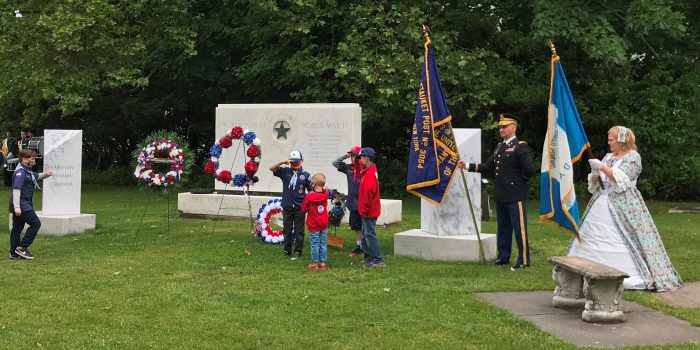
THANK YOU VETERANS!
Each November, individuals across the United States gather to remember and honor the brave men and women who devoted their lives to maintaining the freedoms U.S. residents continue to enjoy. Veterans Day is celebrated on November 11 and pays tribute to all American veterans — including the living and deceased — but especially thanks the living veterans who served honorably during war or peacetime, according to History.com.
Veterans Day originally was known as Armistice Day, which was established to commemorate the end of World War I. In 1954, President Dwight D. Eisenhower officially changed the name of the holiday to Veterans Day in an effort to recognize all veterans.
That name change is just one of many interesting facts about Veterans Day.
• November 11, 1918, was largely considered the end of the “war to end all wars,” even though the Treaty of Versailles, which officially ended World War I, was signed roughly seven months later on June 28, 1919.
• The last living American WWI veteran, Frank Buckles, died in 2011.
• While Veterans Day is an American holiday, Canada, Great Britain, Australia, and France also honor the veterans of World War I and World War II on or near November 11th. Canada celebrates Remembrance Day, while Britain observes Remembrance Sunday each year on the second Sunday of November.
• The United States Bureau of Labor Statistics indicates women make up approximately 10 percent of the veteran population. By 2025, that number is expected to climb to 12 percent.
• In 2016, President Barack Obama signed the Veterans Day Moment of Silence Act. At 3:11 p.m. (Atlantic Standard Time) on Veterans Day, a moment of silence is observed and continues for 120 seconds.
• Data from the Department of Veterans Affairs says there are around 19 million U.S. veterans as of 2021.
East Setauket
VFW Post 3054 will host a veterans recognition service at the Memorial Park at the corner of Shore Road and Route 25A in East Setauket on Nov. 11 at 11 a.m. Residents are invited to join local veterans for a short ceremony that will feature the laying of wreaths from local community groups. For further details, call 631-751-5541.
Greenlawn
Hosted by American Legion Post 1244, a Veterans Day ceremony will be held at Greenlawn Memorial Park, Pulaski Road, Greenlawn on Nov. 11 at 11 a.m. with neighboring American Legion posts plus many community groups and Scouts. Call 516-523-9391.
Port Jefferson
American Legion Wilson Ritch Post 432 invites the community to attend its Centennial Veterans Day/Armistice Day Memorial Observance Remembrance at Veterans Memorial Park on East Broadway in Port Jefferson (across from Village Hall) on Nov. 11 at 11 a.m. For more information, call 631-626-2911.
Smithtown
Smithtown American Legion Post 833, and Smithtown Veterans of Foreign Wars Post 10870 will hold a Veterans Day Ceremony honoring our nations veterans at Veterans Plaze, Main St., Smithtown on Nov. 11 at 10:45 p.m. Local Boy and Girl scout troops, Smithtown HS students, State, County and Town dignitaries will participate in the event.Questions? Call 724-1804.
Sound Beach
The Sound Beach Civic Association will hold a Veterans Day service on Nov. 11 at the Sound Beach Veterans Memorial Park on New York Ave. at 11 a.m. All are welcome. For more information call 631-744-6952.
St. James
Sgt. John W. Cooke VFW Post 395 will host a Veterans Day Parade in St. James on Nov. 11. The parade will kick off at 10 a.m. and head down Lake Avenue to St. James Elementary School. For more info, call 516-987-6201.
